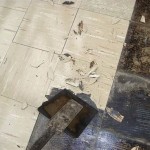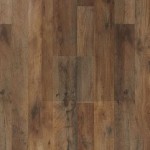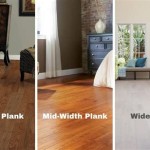Laminate Flooring with Flush Stair Nose: A Comprehensive Guide
Laminate flooring offers a cost-effective and aesthetically versatile alternative to hardwood, stone, or tile. Its durability, ease of installation, and variety of styles make it a popular choice for homeowners and contractors alike. One of the key considerations when installing laminate flooring, particularly in multi-level homes, is the treatment of staircases. The integration of laminate flooring onto stairs requires careful planning and the selection of appropriate transition pieces, with the flush stair nose being a prominent option.
A stair nose, also known as a stair edging or bullnose, is a specialized molding designed to cover the exposed edge of the stair tread. It provides a finished look, protects the edge from wear and tear, and, most importantly, enhances safety by creating a smooth transition and preventing tripping hazards. Flush stair noses, specifically, are designed to sit evenly with the laminate flooring surface, creating a seamless and contemporary aesthetic.
This article will delve into the intricacies of using laminate flooring with flush stair noses, covering their benefits, installation techniques, considerations for selection, and potential challenges.
Understanding the Benefits of Flush Stair Noses
The use of flush stair noses in laminate flooring installations offers several distinct advantages over other types of stair edging. These benefits encompass both aesthetic appeal and functional performance, making them a compelling choice for many projects.
Aesthetic Appeal: Flush stair noses provide a clean, modern, and minimalist look. The seamless transition between the laminate flooring and the stair nose creates a visually appealing surface that avoids abrupt changes in height. This is particularly desirable in contemporary home designs where clean lines and simple forms are prioritized. A flush installation minimizes shadows and visual clutter, contributing to a more refined and sophisticated appearance.
Enhanced Safety: By creating a smooth and even surface, flush stair noses reduce the risk of tripping and stumbling. The absence of a protruding edge eliminates a potential catch point for shoes, socks, or bare feet. This is particularly important in homes with young children, elderly individuals, or those with mobility impairments. The consistent surface also allows for easier and safer navigation of the staircase, contributing to a safer living environment.
Durability and Protection: The stair nose acts as a protective barrier for the exposed edge of the laminate flooring on the stair tread. This edge is particularly vulnerable to impacts, scratches, and chipping from foot traffic and other forms of wear and tear. The stair nose, being a more durable material than the laminate flooring itself, absorbs much of this impact and protects the underlying flooring from damage. This extends the lifespan of the flooring on the stairs and reduces the need for frequent repairs or replacements.
Ease of Cleaning: The smooth surface of a flush stair nose simplifies cleaning and maintenance. Unlike stair noses with crevices or protruding edges, flush installations do not trap dirt, dust, or debris. A simple sweep or damp mop is typically sufficient to keep the surface clean and free of contaminants. This simplifies the cleaning process and contributes to a more hygienic living environment.
Versatility in Design: Flush stair noses are available in a variety of materials, colors, and finishes, allowing for seamless integration with the chosen laminate flooring. They can be matched to the flooring pattern and color to create a unified look, or they can be used as a contrasting accent to add visual interest. The availability of different profiles and sizes further enhances the design versatility of flush stair noses, allowing them to be adapted to a wide range of staircase designs and architectural styles.
Installation Techniques for Flush Stair Noses
Proper installation is crucial for achieving the desired aesthetic and functional benefits of flush stair noses. The installation process requires precision, attention to detail, and the use of appropriate tools and materials. While specific techniques may vary depending on the manufacturer's instructions and the staircase design, the following general guidelines apply:
Preparation is Key: Before beginning the installation, thoroughly clean and prepare the stair treads. Ensure that the surface is level, smooth, and free of any debris, dirt, or imperfections. Any existing damage should be repaired prior to installation to provide a solid and stable foundation for the laminate flooring and the stair nose. Measure each stair tread accurately to determine the required length of the laminate flooring and the stair nose. Account for any slight variations in the treads to ensure a consistent and professional finish.
Cutting and Fitting the Laminate Flooring: Cut the laminate flooring planks to the appropriate width and length for each stair tread. It is essential to ensure an accurate and precise fit. Use a saw with a fine-tooth blade to minimize chipping and splintering. Dry-fit the laminate flooring planks on the stair tread to check for any gaps or overlaps. Make any necessary adjustments before proceeding with the adhesive application.
Applying Adhesive: Once the laminate flooring planks are properly cut and fitted, apply a high-quality construction adhesive to the stair tread. Follow the manufacturer's instructions for adhesive application, ensuring that the adhesive is evenly distributed across the entire surface. Press the laminate flooring planks firmly onto the adhesive, ensuring full contact and proper adhesion. Use a roller or a rubber mallet to apply even pressure and eliminate any air pockets.
Installing the Flush Stair Nose: After the laminate flooring is securely adhered to the stair tread, apply construction adhesive to the back of the flush stair nose. Position the stair nose carefully on the front edge of the stair tread, ensuring that it is flush with the top surface of the laminate flooring. Use clamps or weights to hold the stair nose in place while the adhesive cures. Be careful not to damage the laminate flooring or the stair nose during this process. Wipe away any excess adhesive with a damp cloth.
Finishing Touches: Once the adhesive has fully cured, remove the clamps or weights. Inspect the installation for any gaps or imperfections. Apply a bead of caulk along the edges of the stair nose to seal any gaps and prevent moisture from penetrating the subfloor. Clean the surface of the laminate flooring and the stair nose with a mild detergent and water to remove any residue. Install any necessary trim or molding to complete the installation and provide a finished look.
Safety Precautions: When working with power tools, always wear appropriate safety gear, including safety glasses, gloves, and hearing protection. Follow the manufacturer's instructions for all tools and materials. Work in a well-ventilated area when using adhesives or sealants. Dispose of waste materials properly in accordance with local regulations.
Considerations for Selecting Flush Stair Noses
The selection of the appropriate flush stair nose is critical to the success of the laminate flooring installation. Several factors should be considered when choosing a stair nose, including the material, profile, size, color, and finish. A well-chosen stair nose will enhance the aesthetic appeal, durability, and safety of the staircase.
Material: Flush stair noses are available in a variety of materials, including laminate, wood, metal, and vinyl. The choice of material will depend on several factors, including the desired aesthetic, the durability requirements, and the budget. Laminate stair noses are typically the most affordable option and offer a good match to the laminate flooring. Wood stair noses provide a more natural and elegant look but may require more maintenance. Metal stair noses are highly durable and offer a modern, industrial aesthetic. Vinyl stair noses are water-resistant and are a good option for areas with high humidity or moisture.
Profile: The profile of the stair nose refers to its shape and design. Different profiles offer different aesthetic and functional benefits. Common profiles include bullnose, square edge, and rounded edge. Bullnose stair noses have a rounded edge that provides a smooth and comfortable transition. Square edge stair noses have a sharp, clean edge that creates a modern look. Rounded edge stair noses provide a softer and more forgiving edge that is less likely to cause injury. The choice of profile will depend on the desired aesthetic and the safety requirements.
Size: The size of the stair nose should be appropriate for the thickness of the laminate flooring and the depth of the stair tread. The stair nose should be wide enough to cover the entire edge of the laminate flooring and provide adequate support. The height of the stair nose should be flush with the top surface of the laminate flooring to create a seamless transition. Accurate measurements are essential for selecting the appropriate size stair nose.
Color and Finish: The color and finish of the stair nose should complement the laminate flooring. Matching the color and finish of the stair nose to the laminate flooring will create a unified and cohesive look. Alternatively, a contrasting color or finish can be used to create a more distinct and visually interesting design. Consider the overall design style of the room when selecting the color and finish of the stair nose.
Manufacturer Recommendations: Always consult the manufacturer's recommendations for the appropriate stair nose for the specific laminate flooring being used. The manufacturer may offer specific stair noses that are designed to work seamlessly with their flooring products. Following the manufacturer's recommendations will help to ensure a successful and long-lasting installation.
Potential Challenges and Solutions
While installing laminate flooring with flush stair noses can significantly enhance the aesthetics and functionality of a staircase, certain challenges may arise during the process. Understanding these potential challenges and implementing appropriate solutions can streamline the installation and ensure a satisfactory outcome.
Uneven Stair Treads: One common challenge is dealing with uneven stair treads. If the treads are not perfectly level, the laminate flooring and the stair nose may not sit flush, resulting in gaps or uneven surfaces. To address this issue, it is essential to level the stair treads before installation. This can be achieved by using shims or self-leveling compound to create a smooth and even surface. Accurate measurements and careful preparation are crucial for preventing this problem.
Gaps Between Laminate and Stair Nose: Even with careful installation, small gaps may still appear between the laminate flooring and the stair nose. These gaps can detract from the overall aesthetic and create potential tripping hazards. To fill these gaps, use a color-matched caulk or sealant. Apply the caulk carefully and smoothly, and wipe away any excess with a damp cloth. The caulk will create a seamless transition and prevent moisture from penetrating the subfloor.
Loose or Unstable Stair Nose: If the stair nose is not securely attached to the stair tread, it may become loose or unstable over time. This can create a safety hazard and require costly repairs. To prevent this issue, use a high-quality construction adhesive and ensure that the stair nose is properly clamped or weighted during the curing process. Additional mechanical fasteners, such as screws or nails, may also be used to provide extra security.
Matching Laminate Grain Direction: Maintaining a consistent grain direction between the laminate flooring on the stair tread and riser can contribute to a more visually appealing and professional finish. Carefully plan the layout of the flooring to ensure that the grain direction is consistent throughout the staircase. This may require more careful cutting and fitting, but the result will be a more aesthetically pleasing installation.
Cutting Complex Angles: Some staircases may feature complex angles or curves that require more intricate cutting and fitting. Use a protractor or angle finder to accurately measure the angles and transfer them to the laminate flooring and stair nose. Use a jigsaw or a miter saw to make precise cuts. Practice on scrap pieces before cutting the final pieces to avoid costly mistakes.

Flush Stair Nosing From Laminate Evp Flooring Salty Custom Vinyl

Flush Mount Stair Nose Discount Truehardwoods Com

Laminate Flush Stair Nosing Gray Vfo Flooring

Aspen Flooring Waterproof Rigid Core Flush Stair Nosing In The Color Pure 0 98 T X 4 33 W 94 L Hdspc4ns Home Depot

Aspen Flooring Waterproof Rigid Core Flush Stair Nosing In The Color Pure 0 98 T X 4 33 W 94 L Hdspc4ns Home Depot

Flush Stair Nosing Treads Made From Laminate Floor Plank Evp Or Spc With An Extruded Core Custom Flooring

Laminate Flush Stair Noses What Are They And Should I Get Them Browse Our Mount Nose S

Laminate Flush Stair Nosing Vfo Flooring

Laminate Flooring Msi Glenridge Flush Stair Nose Aged Hickory Liquidators

Responsive Allure Trim Flush Stairnose Flooring Market
Related Posts








